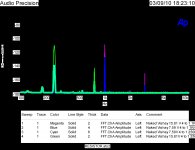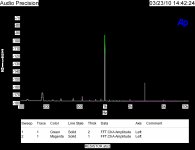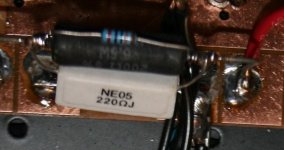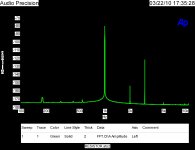Not trying to weigh in as an expert-----I am not one---
but, it seems to me that perhaps what you need is some visual of what may be occurring in your circuit. For instance, one morning I took my Dayton WT3 woofer tester and started running some parameters sweeps on several low resistance 5 watt types I had in order to see what they would look like. It was pretty eye opening to see a rising impedance curve on some of the types including some Mills resistors. The only one that swept ruler flat was an Arcol 8 ohm 25 watt piece that I keep around for a test load. Maybe your resistors are exhibiting some of this rising impedance with frequency attributes?
Just 2 cents worth
Terry
but, it seems to me that perhaps what you need is some visual of what may be occurring in your circuit. For instance, one morning I took my Dayton WT3 woofer tester and started running some parameters sweeps on several low resistance 5 watt types I had in order to see what they would look like. It was pretty eye opening to see a rising impedance curve on some of the types including some Mills resistors. The only one that swept ruler flat was an Arcol 8 ohm 25 watt piece that I keep around for a test load. Maybe your resistors are exhibiting some of this rising impedance with frequency attributes?
Just 2 cents worth
Terry
The way you have combined the resistors will not affect the noise to any serious extent. Thermal noise depends on temperature and resistance.
Attached are my distortion measurements of the naked Vishays and Resistas. The 1K test tone is notched as much as possible. If you can read these you will see the Reisita adds third order harmonic distortion to the mix.
Attached are my distortion measurements of the naked Vishays and Resistas. The 1K test tone is notched as much as possible. If you can read these you will see the Reisita adds third order harmonic distortion to the mix.
Attachments
Oh for Pete's sake.....
Gawd, its perfectly obvious what these vishay things are....!
S.M. resistors soldered to wires!
And a DAFT Price-tag to boot! Just another audiofool 'toy' IMHO!
How enlightening. Attached are the measurements for the same manufacturer's surface mount resistor, same value. 60 db more distortion and noise modulation showing up also!
Attachments
Hmm..
Well that implies their own SM resistors are Crap....
Which I'm sure they aint, or they wouldnt sell to most major manufacturerrs worldwide....
Its all called, Marketing! You'll not catch me buying 'em Thats for sure!
Smoke and mirrors matey....
But, Thats just My opinion.....
Well that implies their own SM resistors are Crap....
Which I'm sure they aint, or they wouldnt sell to most major manufacturerrs worldwide....
Its all called, Marketing! You'll not catch me buying 'em Thats for sure!
Smoke and mirrors matey....
But, Thats just My opinion.....
If it can't be measured or theoretically explained, it is a part of audio fantasy, not audio reality. Better to keep these two apart.
Greetings,
Andreas
Dammit Spock not everything can be explained by your Vulcan logic!
Sorry couldn't resist. I am inclined to agree though, this is a psychological change not a physical one. If this parallel naked resistor works for you there's a whole world of fascinating little modifications about to open up to you.
Last edited:
A resistor that adds no "tone" of its own to my music signal would be the most pleasing one to me. Same for all other components.
When I start hearing differences between power cables and green-marker threated CDs I'll quit this hobby...
Sorry for being off-topic.
Greetings,
Andreas
I think you'll accrue a lot more non-scientific allies when studios start churning out recordings that sound like music instead of the compressed, clipping riddled crap that occupies a majority of the industry. Until then, adding a little flavour from noisier parts can be a workaround to make things a tad more palatable.
Hmm..
Well that implies their own SM resistors are Crap....
Which I'm sure they aint, or they wouldnt sell to most major manufacturerrs worldwide....
Its all called, Marketing! You'll not catch me buying 'em Thats for sure!
Smoke and mirrors matey....
But, Thats just My opinion.....
Have you compared their surface mount resistors to any others? Naked Vishays are not surface mounts, surface mounts don't behave as well as larger thermal mass and tighter end connection resistors. That is called engineering.
- Status
- This old topic is closed. If you want to reopen this topic, contact a moderator using the "Report Post" button.
- Home
- Design & Build
- Parts
- Pitfalls of paralleling different resistor brands?



